A new measurement fuels an ongoing debate about the rate at which today’s universe is expanding.
Reproduceability is key to science. A one-time “eureka!” could be the first step in a paradigm shift — or it could be a fluke. It’s the second, third, and hundredth measurements that put theories to the test.
That’s why recent measurements of the universe’s expansion have piqued interest. Even though astronomers have applied multiple methods relying on completely different physics, they’re still getting similar results: Today’s universe appears to be expanding faster than what’s expected based on measurements of the early universe. Can systematic errors explain this discrepancy? Or are new physics required?
Now Wendy Freedman (University of Chicago) and colleagues have posted a new, "middle-of-the-road" measurement on the astronomy preprint arXiv, adding a twist to the ongoing debate. The study will appear in the Astrophysical Journal.
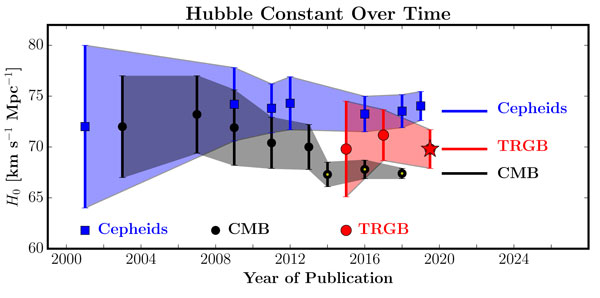
Freedman et al. / Astrophysical Journal
Hubble Constant: Near vs. Far
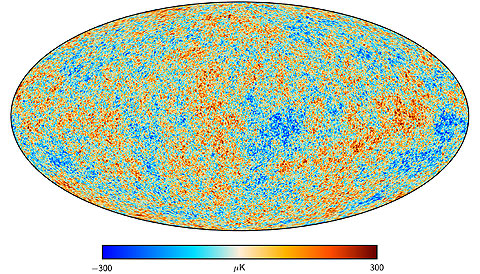
Planck Collaboration
There are two ways that astronomers can estimate the current expansion rate, also known as the Hubble constant (H0). The first is to look way back in time and space.
Exquisitely precise measurements of the cosmic microwave background (CMB), the Big Bang’s “afterglow,” provide a window into the young universe. Tiny temperature fluctuations in this background radiation correlate to density variations in a cosmos only 370,000 years old, which in turn relate to the structure of galaxies and galaxy clusters in the universe today, roughly 13.8 billion years later. Cosmologists can reproduce every last wiggle of those temperature variations using the so-called “Lambda CDM” model, a scenario where dark matter and dark energy rule the universe.
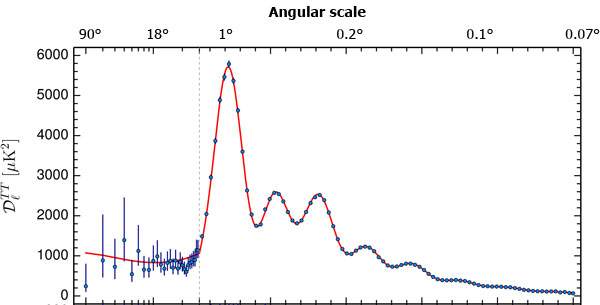
Planck Collaboration
The most recent Hubble constant measurements in this vein come from the Planck satellite: 67.4±0.5 km s-1 Mpc-1. (Yes, those are weird units: here’s why.) Other, independent methods based on properties of the early universe end up with a similar number.
Astronomers can also estimate the expansion rate in the modern-day universe, by measuring the rate at which galaxies appear to fly away from our own. The trick is to find the galaxies’ correct distances. That’s where standard candles come in: Astronomers can measure the brightness of these objects and compare them to their known luminosity to calculate their distance.
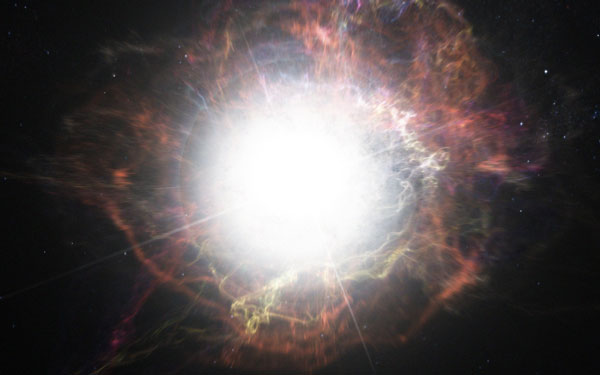
ESO / M. Kornmesser
Here’s where it starts to get interesting: Measurements using relatively nearby objects, such as Type Ia supernovae, Cepheid variable stars, and other standard candles result in a larger Hubble constant, with values between 73 and 76 km s-1 Mpc-1. In other words, the universe appears to be expanding faster now than what’s expected based on observations of the early universe.
And now for the twist: A new study using a new kind of standard candle finds a middle-of-the-road Hubble constant: 69.8±1.9 km s-1 Mpc-1. The result, taken on its own, agrees both with measurements of the cosmic microwave background and with nearby standard candles.
Red Giant Standard Candles
The standard candle Freedman and colleagues are using are red giant stars; specifically, red giant stars that have just made the transition from burning hydrogen to igniting helium.
“Think of it as scanning a crowd to identify the tallest person — that’s like the brightest red giant experiencing a helium flash,” says Christopher Burns (Observatories of the Carnegie Institution for Science). “If you lived in a world where you knew that the tallest person in any room would be that exact same height — as we assume that the brightest red giant’s peak brightness is the same — you could use that information to tell you how far away the tallest person is from you in any given crowd.”
Astronomers find these stars in galaxies’ outermost reaches, which means that there’s no intervening dust to affect observations. So red giant stars provide a way to measure distance that’s free of some of the systematic issues plaguing Cepheid stars and other standard candles.
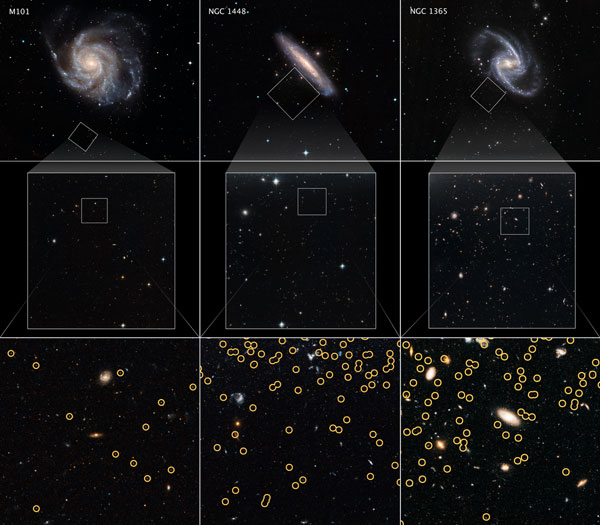
NASA / ESA / W. Freedman (Univ. of Chicago) / ESO / Digitized Sky Survey
Unsettled
Nevertheless, as Freedman and colleagues point out in their paper, the near-far discrepancy remains. Even though their study gives a lower value of the Hubble constant, it’s still on the high end compared to studies of the early universe. If, say, 67.4 were truly the correct value of the Hubble constant, then statistically speaking you’d expect at least a couple measurements to be below it.
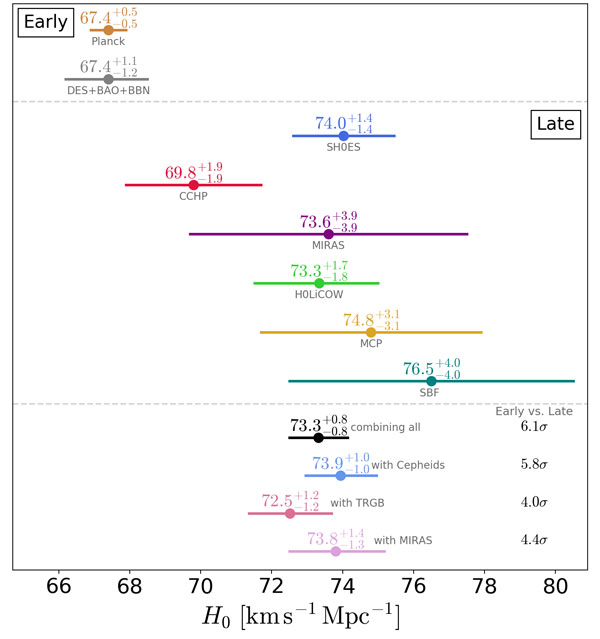
Vivien Bonvin / HOLiCOW Team
Adam Riess (Johns Hopkins University), who has led several recent studies of Cepheid variable stars, points out that a lot depends on how the red giant stars are calibrated. Freedman and colleagues anchor their observations in the Large Magellanic Cloud, where both Cepheid variables and red giant stars reside. Here, unlike in galaxy haloes, the astronomers must account for dust. Riess thinks the large amount of dust estimated by Freedman’s team may explain why their measurement of the Hubble constant is so low.
Ultimately, current measurements won’t settle the debate. Freedman and colleagues argue that to resolve the tension, astronomers must locally measure the Hubble constant to a precision better than 1%. That’s out of reach for now, but in just a couple years, the European Space Agency’s Gaia mission will be providing trustworthy and exquisitely precise distances to a heap of red giant stars, allowing a far better calibration than what is possible now. Perhaps then we’ll resolve the Hubble constant debate for once and for all.
Further reading: Find the full back story on the cosmic controversy surrounding the Hubble constant in the June 2019 issue of Sky & Telescope.
 7
7









Comments
TorbjornLarsson
July 25, 2019 at 5:34 am
The TRGB team synthesis on observation trends and the HOLiCOW team on current observations is interesting. We can add two more.
The CMASS void measurements increase the precision of the early consensus to H0 = 67.67 ± 0.90 km s^−1 Mpc^−1 [ https://arxiv.org/pdf/1904.01030.pdf ].
The fully independent, single event and large uncertainty GW170817 updated jet model Hubble rate gives us two choices, the publication choice of scanning over jets with H0 = 70.3 + 5.3 - 5.0, or models scanning over cosmological parameters of 68.1 +4.5 -4.3 and .68.3 +4.4 -4.3 km s^-1 Mpc^-1 respectively [ https://www.nature.com/articles/s41550-019-0820-1 ].
Seeing how the new, and more independent observations - TRGB, voids, GW170817 - cluster H0 in the 68 - 70 km s^−1 Mpc^−1 region, the trend does not call for new physics, I think, it is still within 5 sigma or 4.5 from the 67.8 km s^−1 Mpc^−1 latest standard consensus. If the trend goes above 72.3, the consensus is screwed I take it - but hopefully not by new physics as much as a need to adjust. The Planck team looked at new physics in the 2018 last cosmological parameter synthesis, and that looks iffy.
You must be logged in to post a comment.
Peter Wilson
July 25, 2019 at 11:54 am
"Or are new physics required?" How about a more realistic model, using old physics?
It is not unheard of for nature to be more complicated than first imagined. Specifically, the principle of action/reaction is missing from the Standard Model. The Dark Energy Dialogue--https://youtu.be/4goInwbOix4--argues that action/reaction needs to be included in the model. The video features explanatory graphics, and arguments for-and-against the added complexity of a reaction-term(s).
You must be logged in to post a comment.
Rod
July 26, 2019 at 8:36 am
Well folks, the Hubble Constant does not behave nicely as a *constant*. I searched my home database and found information like this from the past 🙂 "Quick history: (A.) Edwin Hubble is credited with discovering the expanding universe from galaxy red shifts in the 1920s. The result was the Hubble constant which attempts to measure the rate of expansion of the universe. (B.) In the 1930s, the Hubble constant pointed to a universe that started its expansion about 1E+9 years ago. This contradicted what astronomy was teaching about "the development of individual stars and systems of stars takes considerably longer. It is in no way known how this incongruity is to be overcome." Ref: Relativity, The Special and The General Theory, Albert Einstein, Crown Publishers Inc., 1961, p. 134. (C.) In the 1940s and early '50s, not much better, about 1.8E+9 years old universe. Problem with this situation was that radiometric dated rocks were at least 3 billion years old and in 1955, the age of the earth was established at 4.56 billion years old. An error was discovered in measuring galaxy distances based upon Cepheid variables (galaxies much farther away then had been thought). The age of the universe increased to at least 5E+9 years old. Ref: "The Evolutionary Universe" by George Gamow, Scientific American, September 1956. Reprinted in New Frontiers in Astronomy, W.H.Freeman and Company, 1975, p. 320. (D.) Today the Hubble constant points to a universe in the range of 8E+9 <= universe age <= 16E+9 years old. This would be the Hubble time."
You must be logged in to post a comment.
Lawrence
July 26, 2019 at 6:03 pm
Probably a silly thought from someone with only a smattering of knowledge in this area but these numbers don't look that odd to me.
If we assume the universe was very dense in the beginning curvature of space time would be very steep and the inflationary force is constant then the expansion would be impeded by having to climb that steep wall. As the universe expands, the density goes down and the curvature flattens. So there is less gravitational force working against inflation and things should speed up. So today one could expect it to be faster than yesterday by some relationship over time. So Hubble's constant would be a function of time.
You must be logged in to post a comment.
Dobsonite
August 4, 2019 at 1:07 am
Today's theories-tomorrow's belly laugh.
Anyone remember "Phlogiston", and "the ether"?
More studies are needed! (Get those grant proposals cranked out...)
I say this as a former employee of a University High Energy Physics department.....you've never heard an argument until it's done in eight different languages and three tones...
Tune in for Next Week's Theory!
You must be logged in to post a comment.
Deryk Houston
August 11, 2019 at 9:53 am
Impossible to believe that systematic errors are not at the root of this issue.
It's easy to understand that when we look at distant stars we are only seeing them as they were in the past because of the time it takes for their light to reach us....but I can't buy into the idea that no matter which direction we look deep into space, we are supposed to be looking back into the one point where the big bang point in space originated.
I would like to see astronomers assume, just for a moment, that there was no such thing as the Big Bang and then ask a million questions what other explanation could be making the light appear to be red shifted.
instead..... it seems that almost everyone has jumped onto this one big band wagon for the last half a century or more and refuse to seriously consider that they might have it completely wrong......even when there are so many red flags waving at them.
You must be logged in to post a comment.
David777
February 26, 2020 at 6:02 pm
2 X a megaparsec X C, divided by Pi to the power of 21 = 70.98047 K / S / Mpc
is another way of finding Hubble's Constant purely by using algebra alone. A parsec unit for inputting to this equation is the standard 3.26 light years, David
You must be logged in to post a comment.
You must be logged in to post a comment.